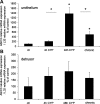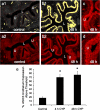Expression and response of acid-sensing ion channels in urinary bladder to cyclophosphamide-induced cystitis
- PMID: 20164155
- PMCID: PMC2867414
- DOI: 10.1152/ajprenal.00618.2009
Expression and response of acid-sensing ion channels in urinary bladder to cyclophosphamide-induced cystitis
Abstract
The expression of acid-sensing ion channel (ASIC) isoforms, ASIC1, ASIC2a, and ASIC3, was examined in the urinary bladder after cyclophosphamide (CYP)-induced cystitis of varying duration (4 h, 48 h, and chronic). Immunohistochemical, Western blot, and quantitative PCR approaches were used to evaluate channel expression and effects of CYP-induced cystitis in whole urinary bladder and split-bladder preparations from control (no inflammation) and CYP-treated rats. Quantitative PCR demonstrated significant (P ≤ 0.01) increases in ASIC2a and ASIC3 transcripts with CYP-induced cystitis (48 h and chronic) in the urothelium but no changes (e.g., ASIC3) or modest changes (e.g., ASIC2a) in detrusor smooth muscle. ASIC1 mRNA expression in the urothelium or detrusor was not affected by CYP-induced cystitis. Immunohistochemistry for ASIC2a and ASIC3 protein expression revealed significant (P ≤ 0.01) increases in ASIC immunoreactivity in the urothelium and suburothelial plexus with CYP-induced cystitis at all time points examined. Western blotting for ASIC2a and ASIC3 protein expression was complementary and revealed significant (P ≤ 0.01) increases in ASIC immunoreactivity. For the first time, these studies demonstrate that CYP-induced cystitis alters ASIC2a and ASIC3 expression in the urinary bladder; ASIC1 transcript expression is not altered by CYP-induced cystitis. Future studies are necessary to determine ASIC isoform contributions to micturition reflexes in control and inflamed urinary bladder.
Figures







Similar articles
-
Expression of corticotropin-releasing factor and CRF receptors in micturition pathways after cyclophosphamide-induced cystitis.Am J Physiol Regul Integr Comp Physiol. 2006 Sep;291(3):R692-703. doi: 10.1152/ajpregu.00086.2006. Epub 2006 Apr 13. Am J Physiol Regul Integr Comp Physiol. 2006. PMID: 16614059
-
Upregulation of vascular endothelial growth factor isoform VEGF-164 and receptors (VEGFR-2, Npn-1, and Npn-2) in rats with cyclophosphamide-induced cystitis.Am J Physiol Renal Physiol. 2008 Sep;295(3):F826-36. doi: 10.1152/ajprenal.90305.2008. Epub 2008 Jul 16. Am J Physiol Renal Physiol. 2008. PMID: 18632792 Free PMC article.
-
Expression of cyclooxygenase-2 in urinary bladder in rats with cyclophosphamide-induced cystitis.Am J Physiol Regul Integr Comp Physiol. 2007 Aug;293(2):R677-85. doi: 10.1152/ajpregu.00305.2007. Epub 2007 May 30. Am J Physiol Regul Integr Comp Physiol. 2007. PMID: 17537839
-
Acid-sensing ion channels 3: a potential therapeutic target for pain treatment in arthritis.Mol Biol Rep. 2010 Oct;37(7):3233-8. doi: 10.1007/s11033-009-9907-6. Epub 2009 Nov 3. Mol Biol Rep. 2010. PMID: 19885742 Review.
-
Cystitis: from urothelial cell biology to clinical applications.Biomed Res Int. 2014;2014:473536. doi: 10.1155/2014/473536. Epub 2014 Apr 30. Biomed Res Int. 2014. PMID: 24877098 Free PMC article. Review.
Cited by
-
Intrabladder PAC1 Receptor Antagonist, PACAP(6-38), Reduces Urinary Bladder Frequency and Pelvic Sensitivity in Mice Exposed to Repeated Variate Stress (RVS).J Mol Neurosci. 2021 Aug;71(8):1575-1588. doi: 10.1007/s12031-020-01649-x. Epub 2020 Jul 1. J Mol Neurosci. 2021. PMID: 32613552 Free PMC article.
-
Development and Assessment of Herpes Simplex Virus Type 1 (HSV-1) Amplicon Vectors with Sensory Neuron-Selective Promoters.Int J Mol Sci. 2022 Jul 30;23(15):8474. doi: 10.3390/ijms23158474. Int J Mol Sci. 2022. PMID: 35955608 Free PMC article.
-
Mechanotransduction in the urothelium: ATP signalling and mechanoreceptors.Heliyon. 2023 Aug 23;9(9):e19427. doi: 10.1016/j.heliyon.2023.e19427. eCollection 2023 Sep. Heliyon. 2023. PMID: 37674847 Free PMC article. Review.
-
Neurosensory mechanotransduction through acid-sensing ion channels.J Cell Mol Med. 2013 Mar;17(3):337-49. doi: 10.1111/jcmm.12025. Epub 2013 Mar 14. J Cell Mol Med. 2013. PMID: 23490035 Free PMC article. Review.
-
Mechanosensitive release of ATP in the urinary bladder mucosa.Purinergic Signal. 2025 Jun;21(3):413-428. doi: 10.1007/s11302-024-10063-6. Epub 2024 Nov 14. Purinergic Signal. 2025. PMID: 39541058 Free PMC article. Review.
References
-
- Abramoff MD, Magelhaes PJ, Ram SJ. Image processing with ImageJ. Biophotonics Int 11: 36–42, 2004
-
- Birder LA. More than just a barrier: urothelium as a drug target for urinary bladder pain. Am J Physiol Renal Physiol 289: F489–F495, 2005 - PubMed
-
- Birder LA. Urinary bladder urothelium: molecular sensors of chemical/thermal/mechanical stimuli. Vascul Pharmacol 45: 221–226, 2006 - PubMed
Publication types
MeSH terms
Substances
Grants and funding
LinkOut - more resources
Full Text Sources

